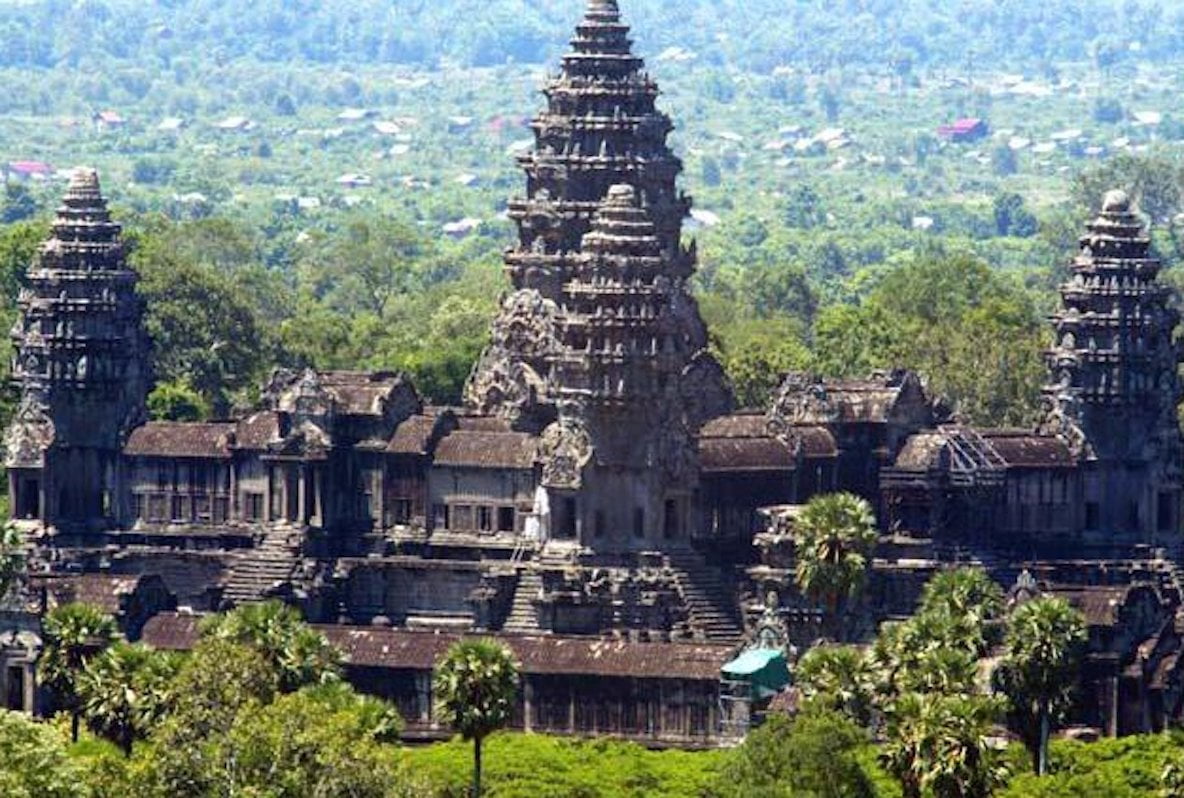Cambodia’s Angkor Wat: A Must Visit for Vaishnavas
By Kumari Kunti Sherreitt | Apr 12, 2013

(Photos by Kumari Kunti Sherreitt.)
Warm breezes blow through the sleepy halls of the Angkor Wat bringing with them the nostalgia of a powerful kingdom. The 800-year-old temple dedicated to Vishnu was once known as “Varah Vishnu-lok” (meaning “holy Vishnu location” in Sanskrit). The towering steeples meld into palm tree grooves, as empty altars and beheaded statues are all that remain of the once prosperous culture, its true glory is preserved only in the intricately carved depictions of the wondrous feats of the ancient Vedic culture and its architecture designed to mimic that of the mythical Mount Meru.
Angkor Wat is a must do pilgrimage for any aspiring Vaishnava, this life. Angkor is the pride of Cambodia, and as a Vaishnava this once city was centered on the temple; where inhabitants lived within the complex and all roads led to the temple, it is easy to feel the roots our Vedic tradition in a place, again, further than India. Angkor’s magic lies in its profound spirituality that has maintanted throughout the centuries. The unique Khemer (what Cambodian people are called) mixed with South Indian styled architecture; along with its deep-rooted Hindu culture makes the site a diamond among jewels.
My husband, Visvambar (from Radhadesh, Belgium), his friend Balaram (from Alachua, Florida) and myself (from Hawaii) made the trek to the Kingdom of Cambodia last month – with Angkor Wat’s grandeur set on our mind; but what we experienced far exceeded any of our expectations.

Angkor Wat. Photo curtesy of the UN.
The Angkor Wat Archaeological Park is a UNESCO World Heritage protected area that hosts more than 200 temples (called wats) from ancient up until modern times. The most famous of all of the wats is Angkor, known for its impressive still-standing structure and wall-to-wall depictions of ancient Vaishnava scriptures, specifically the Srimad Bhagavatam.
Cambodia may not be on the list for many travelers as it has been unchartered for a long time, stuck in cycles of civil war, poverty and even genocide by its own leaders. However in the last ten years the civil conflicts and socialist politics of this war-ridden country had finally settled, and its economy began to rise, although it is still today comparatively worse off then all of its neighboring countries. With the economy change and end of war in the mid-90’s the upkeep of Angkor Wat became a priority of Cambodia and the United Nations.

A scenic site in the Angkor Wat complex.
The Angkor temple has been preserved remarkably, owing to a lot to its large moat that kept the jungle from encroaching after it was abandoned in the 16th century. Today Angkor Wat is the pride of Siem Reap; actually the city only exists as today due to the Angkor complex, where mini replicas are used on everything from signboards to hotel entrances.
ISKCON has one farm and one temple in Siem Reap, as well as the preaching center, however Cambodian devotees are few and the maintenance of these centers are difficult to manage, with most Hare Krsna devotees being from neighboring Indonesia. The temple’s recent campaign has been promoting the temple through placing Jagganath posters on the back of tuk tuks throughout the city.

Devotees at in front of ISKCON’s Siem Reap center.
A few quick facts to help your visit:
1. Angkor Wat; situated within Siem Reap which is easiest to access from Phom Pen the capital city by airport, or by bus or mini-van from Bangkok through the border Poipet.
2. In Siem Reap there is an International Society for Krishna Consciousness (ISKCON) temple. The ISKCON temple has guesthouse facilities in its new building as well as a Govinda’s restaurant, which is in the final stages of opening. The official website is: iskconcambodia.com
3. The ISKCON temple is a 30-minute bicycle ride or 15-min tuk tuk (rickshaw) away from Angkor.
4. Angkor has one-day ($20), three-day passes ($40) and seven day pass ($70) available for purchase at the ticket office. Angkor’s park hours are: 5:00 – 18:00. Your passport is needed for this and they give you a photo ticket card that you have to keep.

Devotees in ISKCON’s Siem Reap center.















